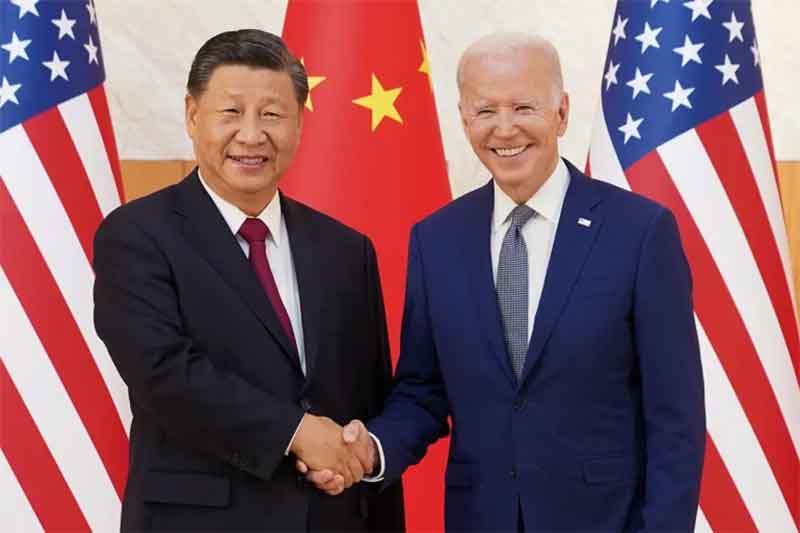
China will become the biggest driver of global growth over the next five years and will contribute double what the U.S. adds, according to the International Monetary Fund.
Based on Bloomberg calculations from data in the IMF’s World Economic Outlook (A Rocky Recovery, April 2023, https://www.imf.org/en/Publications/WEO/Issues/2023/04/11/world-economic-outlook-april-2023) released last week, China’s slice of global gross domestic product expansion will be at 22.6%, India’s will be 12.9%, and the U.S. will add 11.3%.
They are followed by Indonesia, Germany, Turkey, and Japan, each with a less than 3.6% contribution.
Three-quarters of global growth will stem from 20 countries, and over 50% will come from just China, India, the U.S., and Indonesia.
The IMF expects growth contributions from Brazil, Russia, India, and China to outpace Group of Seven nations.
Overall, the IMF anticipates global growth to expand about 3% over the next five years in a higher-interest-rate environment. It is the weakest outlook in over 30 years.
The group’s report highlighted that recent bank turmoil and sticky inflation have heightened recession risks. March brought the collapse of Silicon Valley Bank and Signature, in addition to trouble with Silvergate, Credit Suisse, and other names.
“Risks to the outlook are squarely to the downside,” the IMF said. “Much uncertainty clouds the short- and medium-term outlook as the global economy adjusts to the shocks of 2020–22 and the recent financial sector turmoil. Recession concerns have gained prominence, while worries about stubbornly high inflation persist.”
The World Economic Outlook is a survey by the IMF staff usually published twice a year. It presents IMF staff economists’ analyses of global economic developments during the near and medium term. It gives an overview as well as more detailed analysis of the world economy; considers issues affecting industrial countries, developing countries, and economies in transition to market; and addresses topics of pressing current interest.
The IMF said:
Tentative signs in early 2023 that the world economy could achieve a soft landing — with inflation coming down and growth steady — have receded amid stubbornly high inflation and recent financial sector turmoil. Although inflation has declined as central banks have raised interest rates and food and energy prices have come down, underlying price pressures are proving sticky, with labor markets tight in a number of economies. Side effects from the fast rise in policy rates are becoming apparent, as banking sector vulnerabilities have come into focus and fears of contagion have risen across the broader financial sector, including nonbank financial institutions. Policymakers have taken forceful actions to stabilize the banking system. As discussed in depth in the Global Financial Stability Report, financial conditions are fluctuating with the shifts in sentiment.
It said:
Debt levels remain high, limiting the ability of fiscal policymakers to respond to new challenges.
The IMF said:
The baseline forecast, which assumes that the recent financial sector stresses are contained, is for growth to fall from 3.4 percent in 2022 to 2.8 percent in 2023, before rising slowly and settling at 3.0 percent five years out –– the lowest medium-term forecast in decades. Advanced economies are expected to see an especially pronounced growth slowdown, from 2.7 percent in 2022 to 1.3 percent in 2023. In a plausible alternative scenario with further financial sector stress, global growth declines to about 2.5 percent in 2023 –– the weakest growth since the global downturn of 2001, barring the initial COVID-19 crisis in 2020 and during the global financial crisis in 2009 –– with advanced economy growth falling below 1 percent. The anemic outlook reflects the tight policy stances needed to bring down inflation, the fallout from the recent deterioration in financial conditions, the ongoing war in Ukraine, and growing geoeconomic fragmentation. Global headline inflation is set to fall from 8.7 percent in 2022 to 7.0 percent in 2023 on the back of lower commodity prices, but underlying (core) inflation is likely to decline more slowly. Inflation’s return to target is unlikely before 2025 in most cases. Once inflation rates are back to targets, deeper structural drivers will likely reduce interest rates toward their pre-pandemic levels.
It said:
Risks to the outlook are heavily skewed to the downside, with the chances of a hard landing having risen sharply. Financial sector stress could amplify and contagion could take hold, weakening the real economy through a sharp deterioration in financing conditions and compelling central banks to reconsider their policy paths. Pockets of sovereign debt distress could, in the context of higher borrowing costs and lower growth, spread and become more systemic. The war in Ukraine could intensify and lead to more food and energy price spikes, pushing inflation up. Core inflation could turn out more persistent than anticipated, requiring even more monetary tightening to tame. Fragmentation into geopolitical blocs has the scope to generate large output losses, including through its effects on foreign direct investment.
The IMF said:
Policymakers have a narrow path to walk to improve prospects and minimize risks.
U.S. Credit Crunch Has Started, Says Morgan Stanley
A media report said:
The collapse of Silicon Valley Bank (SVB) and the ensuing banking crisis have triggered a credit crunch in the US, claims Morgan Stanley’s top stock strategist Mike Wilson. He pointed to data that shows a tightening of lending standards by financial institutions.
The warning comes over a month after massive deposit runs caused two lenders, Silicon Valley Bank and Signature Bank, to fail within days. A third lender, First Republic, ended up being the recipient of a $30-billion rescue from top Wall Street banks in the form of deposits. The big players stepped in over investor fears that First Republic would become the next institution to fail.
In a note seen by Business Insider, Wilson said that lending levels have seen the steepest decline on record over the past two weeks. He attributes the drop to US banks’ attempts to offset the breakneck pace of deposit flight in the month since the collapse of SVB.
“The data suggest a credit crunch has started,” the analyst said in a Sunday note, noting that $1 trillion in deposits has been withdrawn from U.S. lenders since the Federal Reserve began its series of rate hikes nearly a year ago.
According to Wilson, major stock indexes holding steady since the failure of SVB should not be taken as an indication of recovery, but rather a sign that stocks are at risk of a sudden drop similar to what has been seen in small caps and bank stocks since March.
“To those investors cheering the softer-than-expected inflation data last week, we would say be careful what you wish for,” Wilson warned, pointing to the March Consumer Price Index report that revealed the inflation rate has been climbing less than projected.
“If/when revenues begin to disappoint, that margin degradation can be much more sudden, and that is when the market can suddenly get in front of the earnings decline we are forecasting.”
In February, Wilson projected U.S. stocks that had previously soared to unsustainable highs could crash 26% within months.















































